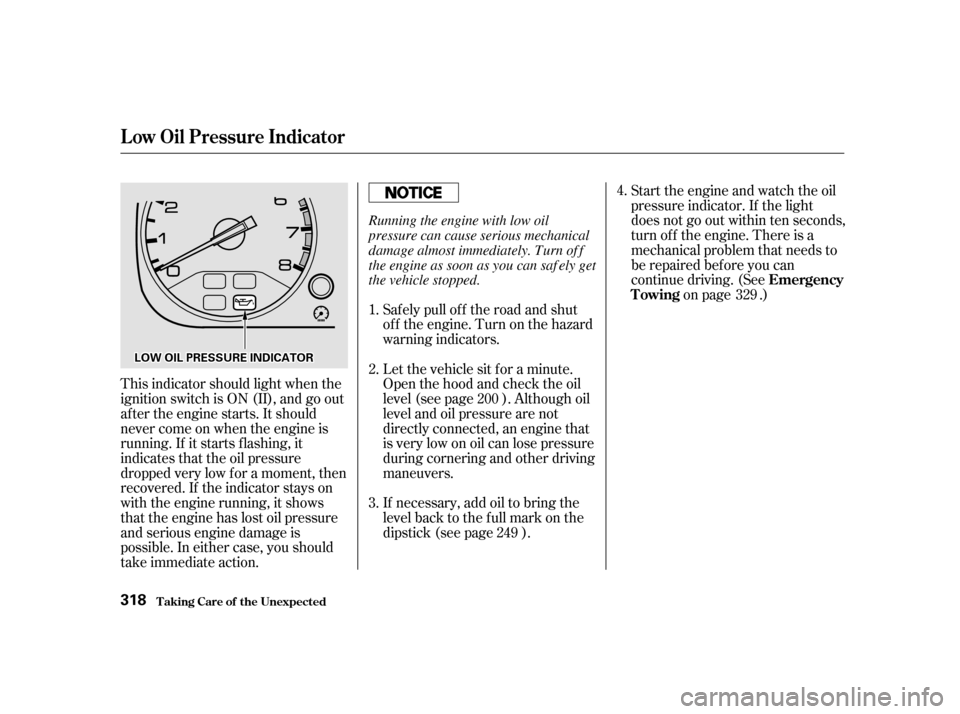Page 314 of 363

Once your vehicle is running,
disconnect the negative cable f rom
your vehicle, then f rom the
booster battery. Disconnect the
positive cable f rom your vehicle,
then the booster battery.The pointer of your vehicle’s
temperature gauge should stay in
the midrange under most conditions.
Itmaygohigherif youaredrivingup
a long steep hill on a very hot day. If
it climbs to the red mark, you should
determine the reason. Your vehicle can overheat for several
reasons, such as lack of coolant or a
mechanical problem. The only
indication may be the temperature
gauge climbing to or above the red
mark. Or you may see steam or
spray coming f rom under the hood.
In either case, you should take
immediate action.
Keep the ends of the jumper cables
away from each other and any metal
on the vehicle until all are
disconnected. Otherwise, you may
cause an electrical short.
7.
CONT INUED
Jump Starting, If Your Engine Overheats
If Your Engine Overheats
T aking Care of t he Unexpect ed315
Steam and spray from an
overheated engine can
seriously scald you.
Do not open the hood if steam
is coming out.
Driving with the temperature gauge
pointer at the red mark can cause
serious damage to your engine.
Page 315 of 363

Saf ely pull to the side of the road.
Put the transmission in Neutral or
Park and set the parking brake.
Turn of f the heating and cooling/
climate control system and all
otheraccessories.Turnonthe
hazard warning indicators.
If you see steam and/or spray
coming f rom under the hood, turn
of f the engine.If you do not see steam or spray,
leave the engine running and
watch the temperature gauge. If
the high heat is due to overloading
(climbing a long, steep hill on a
hot day with the A/C running, f or
example), the engine should start
to cool down almost immediately.
If it does, wait until the tempera-
ture gauge comes down to the mid-
point then continue driving.
If the temperature gauge stays at
the red mark, turn of f the engine.
Wait until you see no more signs
of steam or spray, then open thehood.Look f or any obvious coolant leaks,
such as a split radiator hose.
Everything is still extremely hot,
so use caution. If you f ind a leak, it
must be repaired bef ore you
continue driving (see
on page ).
If you don’t f ind an obvious leak,
check the coolant level in the
radiator reserve tank (see page ). If the level is below the
MIN mark, add coolant to halfway
between the MIN and MAX marks.
1. 2.
3.
7.
6.
5.
4. 329
201
If Your Engine Overheats
T aking Care of t he Unexpect ed Emergency
Towing
316
Page 317 of 363

This indicator should light when the
ignition switch is ON (II), and go out
af ter the engine starts. It should
never come on when the engine is
running. If it starts f lashing, it
indicates that the oil pressure
dropped very low f or a moment, then
recovered. If the indicator stays on
with the engine running, it shows
that the engine has lost oil pressure
and serious engine damage is
possible. In either case, you should
take immediate action.Saf ely pull of f the road and shut
of f the engine. Turn on the hazard
warning indicators.
If necessary, add oil to bring the
level back to the full mark on the
dipstick (see page ).
Let the vehicle sit f or a minute.
Open the hood and check the oil
level (see page ). Although oil
levelandoilpressurearenot
directly connected, an engine that
is very low on oil can lose pressure
during cornering and other driving
maneuvers. Start the engine and watch the oil
pressure indicator. If the light
does not go out within ten seconds,
turn of f the engine. There is a
mechanical problem that needs to
be repaired bef ore you can
continue driving. (See
on page .)
1. 2. 3. 4.
200 249 329
Emergency
Towing
L ow Oil Pressure Indicator
T aking Care of t he Unexpect ed
318
LLOOWWOOIILLPPRREESSSSUURREEIINNDDIICCAATTOORR Running the engine with low oil
pressure can cause serious mechanical
damage almost immediately. Turn of f
the engine as soon as you can saf ely get
the vehicle stopped.
Page 323 of 363
If something electrical in your
vehicle stops working, the first thing
youshouldcheckforisablownfuse.
Determine f rom the chart on pagesand , or the diagram on the
f use box lid (the diagram f or the
driver’s side interior f use box is on
the kick panel below the f use box),
which f use or f uses control that
component. Check those f uses f irst,
but check all the f uses bef ore
deciding that a blown f use is not the
cause. Replace any blown f uses and
check the component’s operation.
Turn the ignition switch to LOCK
(0). Make sure the headlights and
all other accessories are of f .
Remove the cover f rom the f use
box.
The secondary f use box is in the
engine compartment next to the
battery.
The primary under-hood f use box is
located in the back of the engine
compartment on the passenger’s side.
To open it, push the tabs as shown.
1.
2. 327 328
Fuses
T aking Care of t he Unexpect ed Checking and Replacing Fuses
324
UUNNDDEERR--HHOOOODDUUNNDDEERR--HHOOOODD
Page 355 of 363

Fluids..................
Windshield Washer . 258
FM Stereo Radio
...........................
Reception . 162, 174
.................
Folding the Third Seat . 115
.....
Foreign Countries, Driving in . 339
..........................
Four-way Flashers . 75
.................................................
Fuel . 196
......................
Fill Door and Cap . 197
...........................................
Gauge . 67
................
Octane Requirement . 196
...............................
Oxygenated . 338
........................
Reserve Indicator . 65
........................
Tank, Filling the . 197
.....................
Fuses, Checking the . 324
...............
Gas Mileage, Improving . 202
..........................................
Gasohol . 338
.........................................
Gasoline . 196
...............
Fuel Reserve Indicator . 65
...........................................
Gauge . 67
................
Octane Requirement . 196
........................
Tank, Filling the . 197
................
Gas Station Procedures . 197 Gauges
...
Engine Coolant Temperature . 67
...............................................
Fuel . 67
...............................
Speedometer . 66
.................................
Tachometer . 66
GAWR (Gross Axle Weight
.......................................
Rating) . 228
GCWR (Gross Combined Weight .......................................
Rating) . 228
............
Gearshif t Lever Positions . 213
..............................
Glass Cleaning . 298
........................................
Glove Box . 91
GVWR (Gross Vehicle Weight
.......................................
Rating) . 228
.............
Halogen Headlight Bulbs . 282
..............
Hazard Warning Flashers . 75
........................................
Headlights . 70
........................................
Aiming . 282
..............
Automatic Lighting Off . 71
............
Daytime Running Lights . 71
..................
High Beam Indicator . 65
.........................
Reminder Chime . 70
........
Replacing Halogen Bulbs . 282 ...................................
Turning on . 70
............................
Head Restraints . 110
...............................
Heated Mirror . 122
.....................
Heating and Cooling . 136
.............
High Altitude, Starting at . 211
.................
High-Low Beam Switch . 70
HomeLink Universal
.................................
Transmitter . 99
....................................
Hood Latch . 264
.......................
Hood, Opening the . 198
..................................................
Horn . 69
.................................
Hydroplaning . 225
...
Identif ication Number, Vehicle . 332
Ignition
..............................................
Keys . 80
...........................................
Switch . 82
............
Timing Control System . 341
........................
Immobilizer System . 81
.........
Important Safety Precautions . 6
.........
Indicators, Instrument Panel . 61
..................
Individual Map Lights . 133
...............................
Inf ant Restraint . 32
Index
G H I
IV